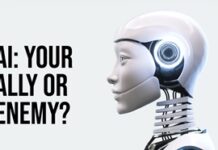
Despite the obvious benefits of biometrics technology, there is still a level of uncertainty surrounding the industry. While the most extreme myths regarding biometric security systems involve information being used for particularly devious purposes, there are a number of other misconceptions surrounding the cost, reliability and installation. In some cases, these misconceptions can leave a company vulnerable and open to danger, especially in an era where increased security measures are becoming more critical.
There has been a steady growth over recent years for biometric security in access control and with the market expected to reach $59 billion by 2025. However, according to Ievo, a UK based biometrics company, slow adoption of some industries using the technology can be attributed to the misunderstandings of how the types of biometric systems work. As such, the company aims to debunk some of the common myths regarding biometrics.
#1 Biometric readers are not safe
This misconception is one of the primary reasons many companies are still yet to adopt biometrics. While it’s bad enough that a password can be stolen; imagine a fingerprint being replicated…? But, that’s not the case.
Biometric data is encrypted and no fingerprint images are stored. Biometrics readers – such as Ievo systems – send a fingerprint image to a control board to be encrypted and stored as a mathematical representation of a fingerprint (or template) to award the individual with certain permissions, via an access control system. Essentially, this fingerprint representation is almost impossible to re-engineer; fingerprints are safe with a biometric security system. However, this is providing the overall security system has been securely installed.
This common misconception also follows neatly into one of the primary advantages of biometrics. A biometric security system can substantially reduce the risk of human error, as employees are not tasked with remembering passwords/PIN codes or ensuring they have a key card with them at all times. Integrate a biometric access control system with time and attendance software and you have a robust and accurate record of employee attendance for payroll, health & safety and fire roll call records.
#2 My company is too small for biometrics
There is a common myth surrounding biometric technology, with many believing the applications are only suitable for government and other high-risk organisations. However, the advantages of biometrics can certainly benefit SMEs and others. For instance, biometric access control systems can save time in logging in and entering the building, reduce waste – such as time slips, punch cards etc. – increase reliability and eliminate any instances of time theft. Most importantly, biometrics can offer your company heightened and reliable security.
Likewise, any business that operates with members (i.e. gyms or clubs) can integrate management software with biometric access control to provide secure access to members only facilities or areas, taking away the need for staffed reception areas.
#3 The technology is not reliable
While it’s true some types of biometrics might have some false positives and false negatives, biometric fingerprint readers provide very high accuracy rates. The readers take a mathematical representation of the fingerprint – detailing the unique characteristics of the individual – and stores them in the database as ‘templates’. As such, it is nearly impossible to replicate the fingerprint and gain access to the building. Most instances of false negatives are results of the readers not being used correctly – such as bot placing a finger correctly on the sensor, using a different finger to the one registered etc.
Biometric access control systems – such as the products available at Ievo – can also be integrated into one system, and allow for simultaneous fingerprint enrolments; offering enhanced reliability. Add to that, biometric technology is certainly more reliable than relying on your employees to remember the latest password and not share with other individuals, or retain their personal key cards (which can easily be forgotten, lost or stolen).
#4 Installing biometrics is costly
One of the biggest misconceptions of biometric verification and readers within many industries is that they are considered expensive. Many directors and business owners simply think about the upfront cost, and less about the long-term savings from adopting various types of biometrics. While the biometric installation will cost slightly more than changing a password, according to Ievo the benefits are unparalleled. You can save costs due to not printing ID cards, as well as labour costs where the payroll department have to sort and deal with timesheets etc.
Biometric costs are also trending down and can substantially vary, depending on the requirements. Fingerprint readers are often also less costly than other types of biometrics and are a proven and secure application. Likewise, biometric companies will also walk you through the installation process and subsequent maintenance. Integration is certainly not as lengthy as some may expect, and some can even be similar to the installation of everyday electrical equipment.
#5 They don’t work in tandem with other systems
There are many biometric devices – including our Ievo readers – that can be integrated with your existing systems, ensuring even more security. Biometrics are not only limited to physical access control for facilities or site entrances. For example, Ievo systems have been integrated into other security products and systems, allowing for biometrically led alarm systems, biometrically controlled security cabinets and key safes alongside other opportunities. In many situations, biometric solutions can considerably heighten the security, efficiency and performance of your business.










